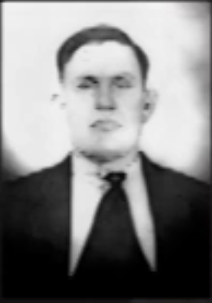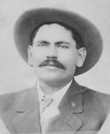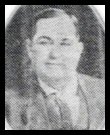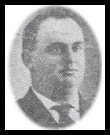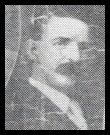Deputy Warden
Oklahoma State Penitentiary
End of Watch January 19, 1914
About the Agency
- Commissioners
- Directors
- Historical Timeline
- Memoriam
1890
The Legislature of the Oklahoma Territory authorized the Governor to contract with the State of Kansas for the incarceration and care of Oklahoma’s convicted criminals. The contracts were signed by the Territorial Governor and the warden of the Kansas Penitentiary and provided for the incarceration of Oklahoma’s criminal inmates who had been sentenced to incarceration for one year or more. For 25 cents per day, per inmate, Kansas provided "food, clothing, bedding, and medical treatment" for the inmates. This contractual arrangement served the needs of Oklahoma during its territorial days. There were numerous attempts by the Territorial Council to get a penitentiary bill passed, but the various governors never signed them into law.
1899
Rising costs and rising populations forced some Oklahoma officials to question the viability of continuing the contracts with Kansas for the incarceration of inmates. An 1899 report to the Governor indicated that the inmate population had reached a new high of 179 for the previous quarter. This growth, plus the increased rate per inmate, resulted in suggesting that the territory’s prisoners be cared for within the territory and that transportation costs be paid by the county where the conviction occurred. This suggestion never materialized.
1907
Charles N. Haskell
First Governor of the
State of Oklahoma
(1907-1911)
Four months into his administration, the first Governor of the state of Oklahoma, Charles N. Haskell (1907-1911), recommended that the legislature appropriate funds to build a penitentiary and reform school in the new state. The legislature did not respond and three weeks before the first session recessed for the summer he sent a special message to both houses. He argued that the convicts were a large expense to the state without producing the slightest material benefit. Convicts could be used to work on the much needed public roads which "need not and should not compete with free labor." Again the legislature failed to act on the penitentiary bill.
Four months into his administration, the first Governor of the state of Oklahoma, Charles N. Haskell (1907-1911), recommended that the legislature appropriate funds to build a penitentiary and reform school in the new state. The legislature did not respond and three weeks before the first session recessed for the summer he sent a special message to both houses. He argued that the convicts were a large expense to the state without producing the slightest material benefit. Convicts could be used to work on the much-needed public roads which "need not and should not compete with free labor." Again the legislature failed to act on the penitentiary bill.
By the end of the first session, the legislature finally authorized the Board of Prison Control to purchase land at McAlester, Oklahoma, and to begin construction of a penitentiary using prison labor. The first contingent of 100 inmates from Lansing arrived on October 14, 1908, and the state temporarily housed this group at the former federal jail at McAlester. Under the direction of the new warden, Robert W. Dick, the inmates built a temporary stockade to house themselves and a second group of inmates from Lansing who Dick planned to use in constructing the permanent penitentiary. The stockade cell house was a clapboard, two-story structure, which measured 30 feet wide by 132 feet long. But the legislature stalled in appropriating funds for the construction of the permanent institution.
Governor Haskell reminded the legislature in January, 1909, that the contract with Kansas was due to expire at the end of the month. Since the legislature had not appropriated the construction funds, and had not yet renewed the contract, he wanted to know what action they would take regarding the 155 inmates at McAlester, over 562 at Lansing, and another 150 in county jails throughout the state that were waiting for "directions as to where they will be transported and confined."
Kate Barnard - Oklahoma's First Commissioner of Charities and Corrections
Barnard had received numerous complaints about the treatment of inmates and the general conditions at the Kansas Penitentiary. Soon after she assumed her official duties she visited the penitentiary at Lansing, Kansas, in August of 1908. She arrived unannounced and, joining other sightseers, paid the normal admittance fee of 50 cents for a guided group tour of the prison and was shown the "showplaces of the institution." After the tour, she identified herself and requested that she be allowed to conduct a thorough inspection. The warden and Kansas Board of Prison Control challenged her authority to inspect their prison, but finally allowed her full access to the facility under the watchful eye of the warden. She completed her inspection and returned to Oklahoma to write her report. She made her report public in December 1908, and demanded a full investigation.
She charged the Kansas authorities with corruption, brutality, and graft in their operation of the prison. Food conditions were terrible, she said, with the prisoners being fed only one meal a day and lower rations than the penitentiaries in Wisconsin and at Leavenworth, Kansas. Kate documented in her report that Kansas contracted the men to private individuals for 50 cents a day and received an additional 40 cents a day from Oklahoma, but spent only 11 cents a day for food.
Kate found that from 1905 to 1908, 60 boys had been sent to the Lansing Penitentiary and many of these were under 16 years of age. This was a clear violation of the contract which stated that "no convict shall be less than 16 years of age." This condition not only gave clear legal and moral grounds for terminating the contract, it also provided Kate with ammunition in her later attempt to establish state industry schools for youngsters in trouble with the law.
Barnard recommended, to the Governor and the legislators of Oklahoma, that all inmates be transferred immediately from Lansing to the federal penitentiary at Leavenworth, Kansas, until Oklahoma could build its own penitentiary.
Conditions at Lansing Cause Public Outcry
The report on the conditions at Lansing brought about a public outcry to bring the prisoners back to Oklahoma. The official report of the investigation of the Lansing Prison was released only a few days after Governor Haskell informed the legislature that the contract with Kansas was to expire within three weeks. The report shocked the legislature into action and it authorized the movement of Oklahoma’s prisoners to McAlester, Oklahoma. After years of infighting, lethargy, and purposeful delay in dealing with the question of convict needs, the legislature finally moved to rectify the situation at Lansing. The legislature appropriated an initial $850,000 to construct the penitentiary.
Oklahoma Corrections Act of 1967
Finally, January 10, 1967, brought the historic announcement from Governor Dewey F. Bartlett in his Legislative address, when he said:
"I have prepared for introduction, today, a bill creating a new Department of Corrections. This bill has been prepared after consultation with leaders of both Houses of the Legislature. It is a joint recommendation of your leadership and the administration. Briefly, this bill provides for the creation of a new State Corrections Department, consisting of a State Board of Corrections, and State Director of Corrections, and three divisions: A Division of Institutions, a Division of Probation and Parole, and a Division of Inspection. The Division of Inspection will perform duties of the present Charities and Corrections Department."
On May 8, 1967, the legislature passed the Oklahoma Corrections Act of 1967. House Bill 566 created the seven-member Board of Corrections, with one member from each of the state’s congressional districts and a seventh member appointed at large.
Oklahoma Charities and Corrections Commissioners
Catherine (Kate) Ann Barnard
1907 - 1915
Kate Barnard was Oklahoma's first Commissioner of Charities and Corrections. She was also the first woman elected to state office in Oklahoma history – and the nation – before women had the right to vote. She persuaded lawmakers to adopt laws governing compulsory education and child labor, and establishing the state's juvenile justice system.
Barnard is perhaps best known for discovering horrific treatment of Oklahoma prisoners in a Kansas prison where they were housed. That led to those inmates' return to Oklahoma, construction of the state's first prison (Oklahoma State Penitentiary), and the establishment of a three-tiered state prison system: a penitentiary, reformatory and boys' training school.
Her advocacy led to 30 new state laws addressing establishment of today's Oklahoma Department of Mental Health and Substance Abuse Services, the Oklahoma Department of Human Services, and the Oklahoma Department of Corrections. The Oklahoma Department of Corrections proudly named one of three female prisons in her honor.
William D. Matthews
1915 - 1923
William Matthews was a veteran of the Confederate Army, a former teacher and Methodist preacher. He was Oklahoma's second Commissioner of Charities and Corrections from 1915 - 1923.
However, when Matthews was elected, then-Gov. Robert Lee Williams appointed him to the state pension board, of which he became chairman. Consequently, most of his time over the state prison system was devoted to his duties with the pension board.
Mabel Luella Bourne Bassett
1923 - 1947
Mabel Bassett was Oklahoma's third Charities and Corrections Commissioner. She was elected for six consecutive four-year terms. Bassett believed the state needed to drastically reform its prison system, improve prison conditions, expand probation services, outlaw inhumane treatment and build a women's prison in McAlester, which now sits empty.
Bassett spent her 24 years in office fighting for what she believed was right, investigating neglect reports in every state orphanage, jail, prison or similar institution. She was a vociferous advocate, arguing mere incarceration would not protect society – only inmate rehabilitation would.
Bassett worked to establish and maintain standards for correctional facilities and state mental institutions. She also established the Oklahoma Pardon and Parole Board in 1944.
For her outstanding contribution to the state, she was inducted into Oklahoma's “Hall of Fame” by the Oklahoma Memorial Association on Statehood Day in 1937.
The Oklahoma Department of Corrections proudly named one of three female prisons in her honor.
Buck Cook
1947 - 1967
Buck Cook, who defeated Mabel Bassett in a 1946 runoff election, was Oklahoma's fourth Commissioner of Charities and Corrections. Under his administration, his office's duties were limited to routine inspections of jails and other institutions.
A former state trooper, he retired after holding the office for 20 years. That same year, the legislature enacted the Oklahoma Corrections Act of 1967, creating a new state agency to administer court-imposed prison sentences.
Jim Cook
1967 - 1977
The State Legislature enacted the Oklahoma Corrections Act of 1967 four months after Jim Cook took office as the fifth Commissioner of Charities and Corrections.
The act created a new Department of Corrections as of July 1, 1967. From 1967-1977, the Department of Corrections had both a Commissioner and a Director.
Cook resigned in 1977 after Oklahoma voters approved a constitutional amendment abolishing the position in 1975. The amendment did not take effect until January 1979.
Jack Stamper
1977 - 1979
An appointee of former Oklahoma Gov. David Boren, Jack Stamper led the Oklahoma Department of Charities and Corrections from October 1977 until the post ended in January 1979. He succeeded Jim Cook of Latimer County, who resigned after Oklahoma voters approved a constitutional amendment abolishing the position.
Before his appointment, Stamper served on the Oklahoma Wildlife Conservation Commission. He resigned that position to accept Boren's appointment.
Stamper was the former owner of the Hugo Daily News, the McCurtain County Gazette, which he bought in 1968, and former co-owner of the Antlers American, his obituary in The Oklahoman states. Stamper was also a veteran who served his country as a U.S. Army intelligence officer in Europe during World War II.
Directors
- Robert William Sumner
- Stephen Roshawn Jenkins, Sr.
- Rance McKee
- Jeff McCoy
- Joe Allen Gamble, Jr.
- Gay Carter
- Kenneth Denton
- Eugene Young
- Rex J. Thompson
- Raymond L. Chandler
- Albert J. Cox
- W. H. Aston
- W. H. "Pat" Riley
- William R. Benningfield
- Jess Dunn
- Charles D. Powell
- William C. Turner
- James Payton "Pate" Jones
- Charles Francis Christian
- William R. Mayfield
- D.C. "Pat" Oates
- Fred C. Godfrey
- Herman H. Drover
Robert William Sumner
Correctional Officer
John Lilley Correctional Center
End of Watch July 14, 2024
Early morning on July 14, 2024, Corporal Robert Sumner was driving an ODOC van on his way to OU Medical Center in Edmond to work a hospital shift when we was involved in a traffic collision with another vehicle. Unfortunately, he passed away from his injuries at the scene. The other vehicle involved was JLCC Corporal Andrew Freppon, who was on his way to the facility to report for duty in his personal vehicle. Cpl. Freppon sustained serious injuries and was medi-flighted to a hospital. Cpl. Sumner and Cpl. Freppon graduated from the ODOC Academy in November 2023.
Corporal Sumner had served with the Oklahoma Department of Corrections for 11 months. He is survived by his wife and two children.
Stephen Roshawn Jenkins, Sr.
Correctional Officer
Clara Waters Community Corrections Center
End of Watch January 7, 2017
Corporal Stephen Jenkins suffered a fatal heart attack shortly after chasing an inmate across the prison yard at the Clara Waters Community Corrections Center in Oklahoma City.
The inmate was observed picking up a bag of contraband tobacco along the inner fence line at the prison. The inmate ran from Corporal Jenkins and three other officers when they attempted to take him inside for a disciplinary action. All four officers chased him across the prison yard before subduing him. Corporal Jenkins suddenly collapsed as they walked into the prison. Corporal Jenkins was transported to a nearby hospital where he passed away.
The inmate was charged with first degree manslaughter as a result of Corporal Jenkins’ death.
Corporal Jenkins had served with the Oklahoma Department of Corrections for 18 months. He is survived by his four children.
Rance Lee McKee
Construction/Maintenance Administrator
James Crabtree Correctional Center
End of Watch December 27, 2016
On December 27, 2016, at approximately 21:45 hours, an officer noticed a smoky haze in the JCCC Unit 4 office area and he could smell a faint ozone aroma, like an overheating electrical appliance. He searched the office area and noticed the smell was stronger in the attic area and inside a case manager’s office. He put the unit on a 30-minute fire watch and requested Central Control to notify the chief of security. He also contacted the maintenance staff on duty, Construction/Maintenance Administrator Rance McKee, to notify him of the issue. Mr. McKee stated he would immediately respond to the facility.
As Mr. McKee was responding to the facility to assist with the problem, he was struck by a vehicle when it failed to yield to a stop sign at an intersection. Mr. McKee was killed in the accident. The chief of security and the warden were called to the scene of the accident by the Oklahoma Highway Patrol who investigated the accident. The OHP investigation determined the other driver was at fault for collision.
Rance had served with the Oklahoma Department of Corrections for 27 years. He is survived by his wife and one son.
Jeff McCoy
Probation and Parole Officer
End of Watch May 18, 2012
On May 18, 2012, Officer Jeffery McCoy, 32, was shot and killed while performing a field visit at a home in Midwest City, Oklahoma.
A male subject who lived at the home, but who was not the focus of Officer McCoy's visit, answered the door and immediately pushed Officer McCoy off of the front porch. The man then attacked him and was able to gain control of his service weapon during the ensuing struggle. The subject shot Officer McCoy at least once before fleeing back into his home. The man fired at officers from the Midwest City Police Department as they arrived at the scene. He was taken into custody moments later after he exited the home again.
Officer McCoy had served with the Oklahoma Department of Corrections for seven years. He is survived by his wife and two children.
Joe Allen Gamble, Jr.
Correctional Officer
Oklahoma State Reformatory
End of Watch June 5, 2000
On June 5, 2000, Sergeant Joe Allen Gamble was assigned to D Unit at the Oklahoma State Reformatory. At 8:15 a.m., Sergeant Gamble heard the call for help from Officer William Callaway. Sergeant Gamble immediately left the area he was counting and went through the unit control room to D-1 pod. When he arrived at D-1 pod, he did not know Officer Callaway had escaped the day room. Thinking only of his friend's call for help and without regard for his own personal safety, Sergeant Joe Allen Gamble entered the day room to save his fellow correctional officer. An inmate armed with two homemade knives ambushed Sergeant Gamble as he entered the day room. Sergeant Gamble was able to escape and ran immediately to medical for treatment. Sergeant Gamble was taken by ambulance to Jackson County Memorial Hospital where he later died from his injuries.
Sergeant Gamble had been with the department for three years.
Gay Carter
Correctional Food Supervisor
R.B. "Dick" Connor Correctional Facility
End of Watch November 13, 1998
Inmate Grant stabbed Ms. Carter in the upper body several times with a homemade knife. Ms. Carter was supervising the cleaning of the dining hall after breakfast. Inmate Grant attacked her in the mop closet of the dining hall.
Kenneth Denton
Correctional Officer
Oklahoma State Reformatory
End of Watch August 3, 1989
At about 9:30 a.m., Officer Denton was transporting five inmate road workers in a Department of Corrections van. On Highway 9 about six miles east of Granite, Officer Denton suffered a heart attack while driving, causing him to lose control of the vehicle which struck a bridge abutment and turned over. Officer Denton was pronounced dead at the scene and five inmates received minor injuries.
Eugene Young
Corrections Officer
Probation and Parole
End of Watch July 28, 1989
On the afternoon of July 28, 1989, at the Oklahoma City probation and parole office, parolee Huey Don Turner was being arrested during his visit to the office preparatory to have his parole revoked. Turner resisted violently, and Officer Young was one of five corrections officers called to subdue him. A short time later, Officer Young suffered a heart attack and died at Presbyterian Hospital in Oklahoma City.
Officer Young was survived by his wife, two sons and two daughters.
Rex J. Thompson
Correctional Officer
Lexington Corrections Center
End of Watch September 1, 1981
On August 31, at about 7 p.m., the prison's officers were in the process of locking all of the inmates in their cells as part of a general lock-down because of a previous fight. Inmate Michael Slazenger attacked Officer Thompson near his station in the control center. Officer Thompson died from severe head injuries the next day.
Officer Thompson was survived by his wife and two children.
Raymond L. Chandler
Correctional Officer
DOC Security - Griffin Memorial Hospital Unit
End of Watch December 18, 1980
Officer Chandler was off duty at a laundry mat in Norman, when a former inmate walked in, and a fight ensued. As the two struggled, both fell through a large plate glass window. A large piece of glass cut Officer Chandler’s jugular vein as he fell. After falling through the window, the semi-conscious officer, dressed in street clothes, fired one shot from a handgun at the offender who was running away, but he did not strike the ex-inmate. Chandler then collapsed and died at the scene.
At the time of his death, Officer Chandler was assigned to the inmate unit at Griffin Memorial Hospital.
Albert J. Cox
Prison Farm Supervisor
Oklahoma State Penitentiary
End of Watch March 5, 1977
At 9:30 a.m., on March 5, 1977 inmate Edward Lyle Hall and employee Albert Cox were discovered missing from the state prison. At 5 p.m., Mr. Cox's body was later found under more than two dozen 50-pound sacks of feed in a chicken coop in the prison farm. He had been stabbed several times and his throat had been slashed by a homemade knife. The pick-up Mr. Cox had left in that morning to make his rounds was missing. It was located abandoned in Johnston County.
Later that day, near Mannsville, the suspect held a knife to the throat of an 11 year-old boy and forced him and his father to drive him to a remote location before releasing them and taking their vehicle. Five days later the car was found abandoned in Florida. On October 4, 1977, the suspect was captured by FBI agents in Denver, Colorado.
Hall, who was serving a 15 year sentence for a 1974 robbery conviction, was convicted of first degree murder and sentenced to death. In 1982, his conviction was overturned and a new trial was ordered. He was found guilty of second degree murder and sentenced to life. Hall has been denied parole several times.
Cox had served with the Oklahoma Department of Corrections for 12 years. He is survived by his wife and two children.
W. H. Aston
Officer
Oklahoma State Penitentiary
End of Watch August 4, 1948
On July 30, Officer Aston was on duty on the fourth floor of the west cellblock that was the solitary confinement area. Officer Aston saw a mirror, prohibited in solitary confinement, extended from Thomas Woods' cell and went to check on it. When he opened the cell door, Woods sprang upon him and began beating Aston's head on the floor, wall, and against the cell bars.
When other officers came to his rescue, Aston was still conscious, and his injuries did not appear to be serious. He was taken to a local hospital but did not want to be admitted. He was examined and sent home, but the next day, his condition worsened. Taken to a hospital in Holdenville, he was diagnosed as suffering from a fractured skull and intra-cranial bleeding. Officer Aston died of his injuries on August 4.
W. H. "Pat" Riley
Chief Sergeant
Oklahoma State Reformatory
End of Watch December 13, 1943
On December 13, prisoner L. C. Smalley told Chief Sergeant W. H. “Pat” Riley that he had been robbed of a watch and $30 by two other prisoners. Smalley told Riley that the men who robbed him were Mose Johnson and Staley Steen. About 3:15 p.m., Sergeant Riley located both suspects in the boiler room where they worked. As he questioned them about the robbery, Johnson hit Riley over the head with a piece of pipe, and Steen stabbed him in the face and back with a knife. Leaving the officer on the floor, the two inmates then ran to the canteen where Smalley worked behind the counter. When the two ran in the canteen, the other inmates ran out before Johnson killed Smalley with an ice pick. Other officers arrested the two in the canteen but not in time to save Smalley.
Sergeant Riley had been with the agency for ten years and was survived by his wife, a daughter and four sons.
William R. Benningfield
Supervisor
State Prison Farm
End of Watch August 11, 1941
James David Parrish, a trusty serving time for Grand Larceny, complained of feeling ill. Mr. Benningfield, an unarmed supervisor, was transporting him to the doctor in Atoka, but they never arrived. The car was found abandoned near Wewoka with the gears stripped. Parrish was arrested that night while hitchhiking near Shawnee, Oklahoma, on Highway 270. Confessing to Benningfield's murder, he led officers to the body in a ditch 14 miles north of Durant. Benningfield had been beaten to death with a claw hammer.
Jess Dunn
Warden
Oklahoma State Penitentiary
End of Watch August 10, 1941
On the morning of August 10, 1941, Warden Dunn was touring the prison with an electrical engineer, planning a new communications system. About 10:45 a.m., prisoners Roy McGee, Bill Anderson, Claude Beaver, and Hiram Prather, armed with homemade knives, tried to break out of the prison. Anderson and Beaver had both been involved in a previous escape attempt that cost the life of Charles Powell four years earlier.
The inmates took Warden Dunn and the engineer hostage and began marching them out in the yard, using them as shields from the officers. Threatening to kill their hostages, the prisoners managed to disarm the officers in the front guard tower. Now armed with guns, they forced their hostages out to the front gate. In the meantime, officers had called the Pittsburg County Sheriff's Office for assistance. Deputy Sheriff Bill Alexander was the only officer on duty, but Deputy William A. Ford was also at the Sheriff's Office although he was off duty. Both deputies had formerly been officers at the prison. The deputies quickly drove to the prison and using their car as a roadblock, about three blocks north of the prison, blocked the exit of the car containing the inmates and hostages. During his time as an officer at the prison, Deputy Alexander had discussed with Warden Dunn how an attempted jailbreak should be handled if hostages were involved. Dunn had told Alexander that if prisoners took him hostage, they would obviously have him order the officers to let them pass and not to shoot. Also obviously, he would give the orders as they told him. However, Dunn told Alexander that the officers should ignore his orders under those circumstances and not let them pass. He also told him that "even if I tell you not to shoot, you shoot."
Claude Beaver was driving with Warden Dunn and the engineer in the front seat of the car with the other three escapees in the rear seat holding them at gunpoint. As expected, the prisoners told Dunn to give the deputies the orders to let them pass. Deputy Alexander told the Warden he could pass but that the other men would not be allowed to leave. One of the prisoners then fired a rifle shot, hitting Deputy Ford in the head. Another prisoner then shot Warden Dunn twice in the back of the head, and Deputy Alexander began returning their fire.
Warden Dunn and Claude Beaver were dead at the scene. Deputy Ford died a few hours later. Bill Anderson died from his wounds two days later. Hiram Prather, also wounded, was the only one of the prisoners to survive. He was charged with Jess Dunn's murder, convicted, and sentenced to die in "Old Sparky," the prison's electric chair.
Charles D. Powell
Brickyard Foreman
Oklahoma State Penitentiary
End of Watch May 13, 1936
About noon on May 11, 1936, the prisoners were being fed lunch in the brickyard when a jail break occurred. Twenty-four men charged at four officers, including Mr. Powell, with prison-made dirks. Powell attempted to escape from them but was struck on the head with a piece of pipe. The four hostage officers, Powell, Tuck Cope, W.W. Gossett, and Victor Conn, were then forced toward the nearest guard tower. When the prisoners demanded that the two tower officers throw down their guns, the officers complied. The now armed inmates forced their captives to a nearby car and fourteen of the escapees crammed themselves into and on the car. As the car began moving, other officers opened fire on the car. Tuck Cope was wounded in the neck, Gossett in the stomach, but Powell was fatally hit in the head. In the resulting melee, ten of the inmates were wounded and six were rapidly recaptured. Eight escaped for periods ranging from a few hours to several weeks, but all were subsequently recaptured.
Officer Powell had been with the agency for five years was survived by his wife and two children.
William C. Turner
Guard Foreman
Oklahoma State Penitentiary
End of Watch July 18, 1935
On July 18, 1935, Guard Foreman Turner was supervising three prisoners on the prison farm about a mile from the main prison building. He was suddenly struck by lightning, killing him and the horse he was riding. The three prisoners were also injured by the lightning.
Guard Foreman Turner had worked at the penitentiary for approximately four years. He was survived by his wife and three children.
James Payton "Pate" Jones
Security Officer
Oklahoma State Reformatory
End of Watch February 17, 1935
On February 17, 1935, Officer Jones was on duty in the main entrance tower. Shortly after 2 p.m., two inmates, Malloy Kuykendall and Henry Stewart led a mass escape attempt with two guns that had been smuggled in to them.
Unfortunately, a group of women and children were taking a tour of the prison at the same time and the prisoners took them hostage. As the group approached the main tower where Officer Jones was on duty, one of the inmates shot him fatally with a shotgun. Officer Jones' wife was standing on the front porch of the officers' barracks a short distance away and saw her husband shot down.
Officer Jones had been with the agency for three years. He was survived by his wife and two children.
Charles Francis Christian
Correctional Office
Oklahoma State Reformatory
End of Watch February 16, 1935
On February 16, 1935, Correctional Officer Charles Francis Christian was the victim of an attack by an inmate while he was supervising a work gang at the Oklahoma State Reformatory. Officer Christian never recovered and succumbed to his injuries from a crushed skull.
William R. Mayfield
Brickyard Supervisor
Oklahoma State Penitentiary
End of Watch January 20, 1926
On January 19, 1926, William R. Mayfield was the supervisor for the brickyard at the Oklahoma State Penitentiary in McAlester. One of the prisoners in the brickyard that day was originally sentenced to five years for burglary but in 1925, the inmate had killed his cellmate and received an additional twenty-five year sentence. This inmate had a plan to escape on this date.
To affect that escape, the inmate threw a brick at Mayfield, striking him in the back of the head which caused a deep wound and a fractured skull. Other officers then shot the inmate. Mayfield succumbed to his injuries and died the next morning.
He was survived by his wife and four children.
At 4:20 p.m., January 19, 1914, three prisoners, (Tom Lane, Chiney Reed, and Charles Kuntz) were making their way through the maximum-security prison's front corridor, ostensibly to see parole officer, Frank Rice. Tom Lane was concealing a handgun that had been smuggled into the prison for him.
As Turnkey J. W. Martin let the inmates through the door, Lane pulled the gun on him and demanded the keys. Martin, alone and unarmed, jumped Lane and struggled with him until Lane shot him in the cheek. The inmates then took the keys and ran down the corridor to the office of Deputy Warden D. C. Oates, intending to take a hostage to help protect their escape from the armed officers in the towers outside.
Turnkey Martin raised the alarm and Deputy Warden Oates came out of his office, drew his handgun and emptied it at the inmates, wounding Kuntz in the chest. Tom Lane returned fire. H. H. Drover was just exiting another room from developing photographs and was fatally hit by one of Lane's shots. Oates ran down the hall to get another gun or more ammunition.
As the inmates burst into the deputy warden's office, they confronted stenographer, Mary Foster; day sergeant F. C. Godfrey; parole officer, Frank Rice; and attorney, John H. Thomas; who was at the prison to see a client. As the inmates told everyone to raise their hands, the elderly Thomas moved too slow to suit them, and Lane shot him fatally. Sergeant Godfrey, who was facing a wall with his hands raised, then attacked Lane, who shot him in the head, killing him instantly. The inmates then took Foster and Rice as hostages, and, shielding themselves behind their hostages, moved out of the office. Deputy Warden Oates, who had rearmed himself with a shotgun, met them in the corridor. Oates ordered Lane to drop his gun, and Lane shot Oates, killing him. Subsequently, all three inmates were killed during the escape attempt.


